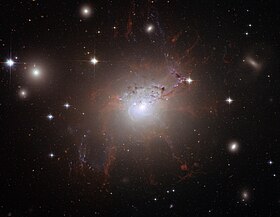NGC 1275
| NGC 1275 | |
|---|---|

Hubble Space Telescope image of NGC 1275
|
|
| Observation data (J2000 epoch) | |
| Constellation | Perseus |
| Right ascension | 03h 19m 48.1s |
| Declination | +41° 30′ 42″ |
| Redshift | 5264 ± 11 km/s z=0.017559 |
| Distance | 222 million light-years 68.2 Mpc |
| Apparent magnitude (V) | 12.6 |
| Characteristics | |
| Type | cD;pec;NLRG |
| Apparent size (V) | 2′.2 × 1′.7 |
| Other designations | |
| Perseus A,PGC 12429,UGC 2669, QSO B0316+413, Caldwell 24 | |
NGC 1275 (also known as Perseus A or Caldwell 24) is a type 1.5 Seyfert galaxy located around 237 million light-years away in the direction of the constellation Perseus. NGC 1275 corresponds to the radio galaxy Perseus A and is situated near the center of the large Perseus Cluster of galaxies.
NGC 1275 consists of two galaxies, a central type-cD galaxy in the Perseus Cluster, and a so-called "high velocity system" (HVS) which lies in front of it. The HVS is moving at 3000 km/s towards the dominant system, and is believed to be merging with the Perseus Cluster. The HVS is not affecting the cD galaxy as it lies at least 200 thousand light years from it.; however tidal interactions are disrupting it and ram-pressure stripping produced by its interaction with the intracluster medium of Perseus is stripping its gas as well as producing large amounts of star formation within it
The central cluster galaxy contains a massive network of spectral line emitting filaments, which apparently are being dragged out by rising bubbles of relativistic plasma generated by the central active galactic nucleus. Long gaseous filaments made up of threads of gas stretch out beyond the galaxy, into the multimillion-degree, X-ray–emitting gas that fills the cluster. The amount of gas contained in a typical thread is approximately one million times the mass of the Sun. They are only 200 light-years wide, are often very straight, and extend for up to 20,000 light-years.
...
Wikipedia
